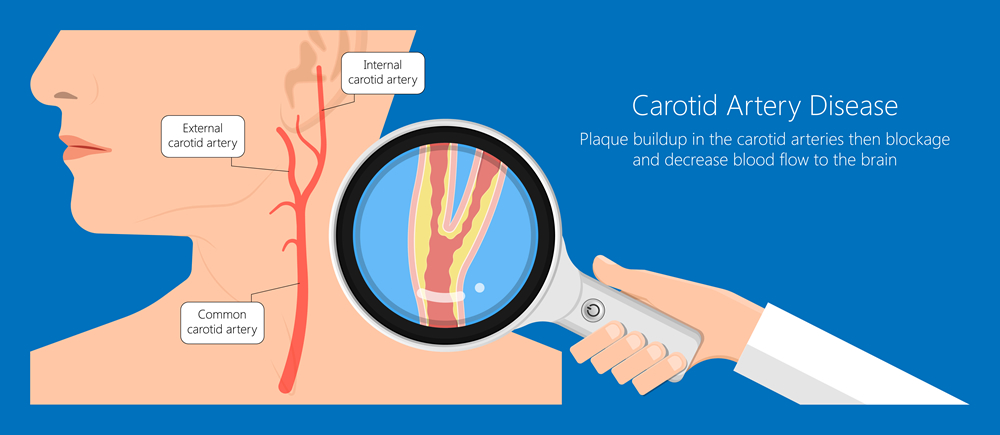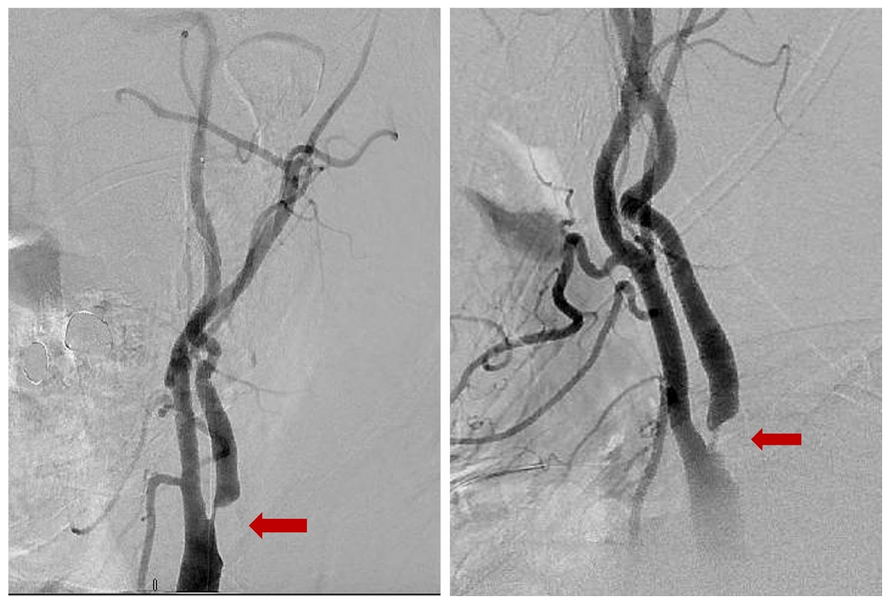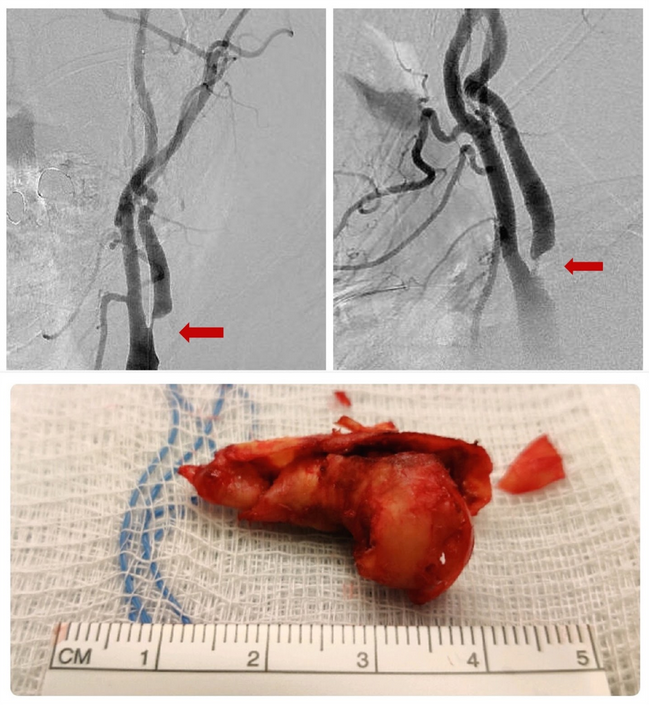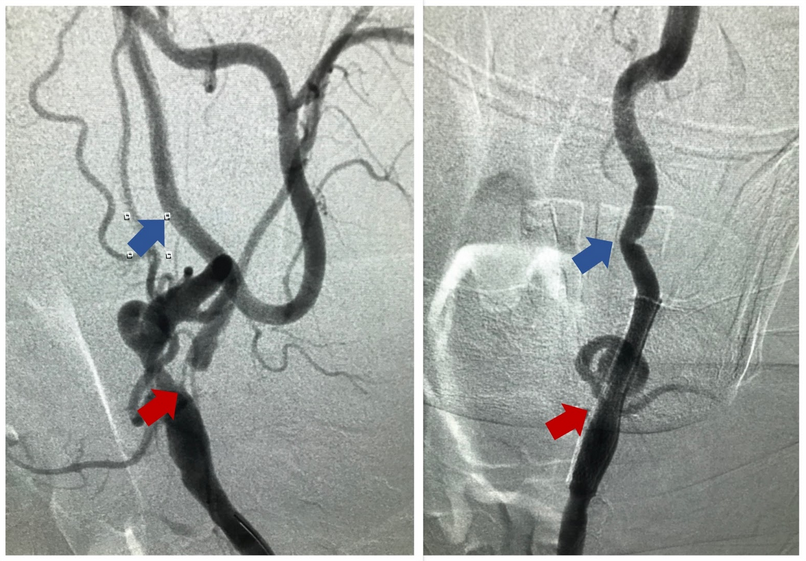Carotid Stenosis is also called carotid disease is a narrowing of the Carotid Artery in your neck, which supplies blood to the brain. Carotid stenosis is most commonly caused by carotid atherosclerosis (buildup of plaque in the artery) or other conditions such as trauma or infection. As the narrowing increases, blood flow to the brain is reduced and blood clots can form leading to stroke.

Figure 1. Carotid Stenosis
Carotid artery disease develops as the buildup of plaque in the blood vessel walls happens gradually and may be silent for years. As a result, people often experience no symptoms, but a routine physical or eye exam can pick up warning signs and prompt imaging studies. Strokes or transient ischemic attacks, which are characterized by an interruption in the flow of blood can be the first symptom and they represent a medical emergency!
Common symptoms of a narrowing on the carotid include:
Transient Ischemic Attacks: A transient ischemic attack (TIA) or “mini-stroke” is an episode of stroke-like symptoms that go away without permanent brain injury. If the patient experiences a TIA, they are at risk of experiencing a larger stroke and should seek medical care immediately.
Acute Ischemic Stroke: numbness or weakness in the face, arm, and leg; drooping on one side of the face; slurring while speaking. Additionally, difficulty understanding speech, balance difficulty. If you or someone you know is having symptoms of a stroke, call 911 immediately!
Visual Changes: If one eye vision suddenly changes, it may indicate a narrowing in the carotid artery on that side of the neck. It is often described as a “curtain” that falls over the field of vision and then returns, the eye’s blood supply can be disrupted by a reduced volume of blood flow of fatty build-up in the artery. If you or someone you know experience any of these symptoms, contact your doctor right away.
There are multiple ways to detect carotid stenosis including:
Bruit: Doctors often hear a high pitch “bruit” sound while examining the neck and chest by using a stethoscope. This can indicate significant narrowing due to carotid stenosis, or narrow arteries leading to the brain.
Carotid Artery Ultrasound Doppler Scan: This is a noninvasive diagnostic test that uses ultrasound to detect the narrowing of arteries in the neck and may provide data about the severity of the stenosis.
CT Angiogram or MRI Angiogram: Both of these tests are able to provide an accurate representation of the neck’s blood vessels in order to inspect for vessel narrowing.
Diagnostic Cerebral Angiogram: This is the most accurate measure, but it is a more invasive diagnostic procedure (includes inserting a catheter) that often only is used if there is no clear answer from a simpler test.

Figure 2. Carotid Angiogram demonstrating severe left internal carotid artery origin stenosis (red arrow)
If someone has had a stroke or TIA because of significant carotid stenosis, their risk of experiencing another is about 25% in the next two years without treatment. The chance a person will experience a stroke if they have asymptomatic carotid narrowing is lower. In general, the narrower the arterial blood vessel, the higher the risk of stroke and narrowing greater than 60% may warrant treatment.
Treatment of carotid artery disease usually involves a combination of lifestyle changes, medication, and sometimes surgery and aims to reduce the possibility of TIA or stroke or to prevent the recurrence of a stroke.
Carotid Endarterectomy: For patients with significant narrowing of the carotid artery that show symptoms of stroke, surgery can be recommended. Carotid endarterectomy surgery involves opening and clamping the artery above and below the plaque buildup and removing it while the artery is clamped.

Figure 3. Carotid Endarterectomy – Cervical angiogram anterior view (upper left) and lateral view (upper right) demonstrating severe carotid stenosis (red arrows). After carotid endarterectomy reopened the vessel, an antherosclerotic plaque that was removed from the diseased vessel wall is pictured (lower image).
Carotid Stenting: Some patients are recommended for carotid angioplasty and stenting instead. This procedure, performed in select cases, provides a self-expanding stent that compresses the blockage of the artery at its site – opening it up and reducing the chance for stroke.

Figure 4. Carotid Stenting – Pre-procedure (left) anterior-posterior view of the left carotid artery demonstrating severe internal carotid artery (ICA) stenosis (red arrow) and normal cervical ICA (blue arrow). After placement of a carotid stent (right), there is resolution of the stenosis (red arrow) and good flow downstream (blue arrow).
For more information on the surgical treatments please visit the treatment section.
